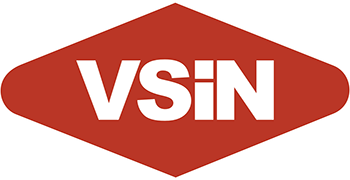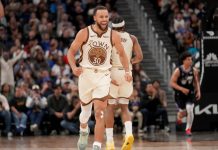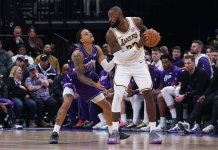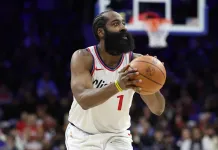The 2025-26 VSiN NBA Betting Guide was released on Tuesday, October 7. The 79-page publication features best bets from our talented VSiN hosts and analysts, betting strategy advice from Jonathan Von Tobel and Kelley Bydlon, and trends/insights from Steve Makinen. The guide also features team-by-team previews for all 30 NBA teams, including one on the Portland Trail Blazers. Keep reading to see how we think the Blazers will do compared to their regular season win total of 35.5.
Make sure you download the 2025-26 NBA Betting Guide for full access to our entire season preview!
Offense
After a rocky start to his coaching career, Chauncey Billups found his footing in 2024-25. Portland went 36-46, making a late push for the Play-In while covering spreads at an impressive 47-34-1 clip. The Blazers were competitive nearly every night, and Billups’ work put him on short lists for other coaching jobs.
The offense remains his biggest challenge. Portland finished near the bottom in adjusted offensive rating (110.9), dragged down by poor shooting and turnovers. The Blazers hit only 34.2% of their threes (fifth-worst in the NBA) and coughed it up 16.0 times per game — better than only Utah. The defense improved after the All-Star break, but the offense never caught up.
Help is on the way, at least on paper. Portland added Jrue Holiday and Damian Lillard in the offseason. Both could have solved shooting and decision-making issues — if healthy. Unfortunately, Lillard tore his Achilles in Milwaukee’s playoff series against Indiana and will miss the entire season.
Scoot Henderson, who averaged 12.7 points and 5.1 assists while showing major growth as a shooter (35.4% from three) and decision-maker, will also miss the first few months with a torn hamstring. Without him, the burden of running the offense falls heavily on Holiday. The veteran is still reliable, but he’s not as explosive as he once was and has to be managed carefully.
That puts more pressure on Deni Avdija and Shaedon Sharpe, two of the most intriguing pieces on this roster. Avdija broke out last season with career highs across the board — 16.9 points, 7.3 rebounds, and 3.9 assists — while shooting 36.5% from deep. He’s a force attacking downhill and has blossomed into a versatile playmaker. Billups may use him as a point forward to ease Holiday’s workload. Sharpe averaged 18.5 points and posted his first positive Offensive EPM (+0.2). His shot mechanics are also too clean for him to stay at 31.1% from three. If that number rises to 35%, his efficiency could jump significantly.
On the wings, Toumani Camara and Jerami Grant add value. Camara is an explosive finisher and cutter who just needs to keep developing his jumper. Grant remains a skilled scorer, but Portland will demand more efficiency from him; empty-calorie buckets won’t cut it for a team pushing toward the postseason.
The center rotation also looks interesting. Deandre Ayton is gone, opening the door for Donovan Clingan to start. He won’t create his own looks, but he’s a good screener, quick decision-maker, and reliable finisher around the rim. He’s also working on a jumper that could come later on. Rookie Yang Hansen, the surprise 16th pick, turned heads at Summer League with his Jokic-like vision and touch. He could contribute in small bursts right away. Robert Williams III remains productive in limited minutes, excelling as a rim runner, rebounder, and passer, but durability is always a concern.
Put together, this roster looks more like a functioning basketball team than last year’s group. But with Henderson sidelined and Lillard unavailable, top-20 efficiency still feels out of reach. Late-game shot creation will be a major weakness.
Defense
Portland’s turnaround last season came on this end. From February 1 onward, the Blazers ranked fourth in points allowed per 100 possessions (112.0). Billups has set the expectation for them to remain one of the NBA’s stingiest defenses.
It starts with Holiday. Even at 34, he finished in the 92nd percentile in Defensive EPM (+1.5) — his sixth straight year in the 90th percentile or better. He still plays chest-to-chest defense, pressures the ball, and switches across multiple positions. Camara earned All-Defensive Second Team honors in his second season, already profiling as one of the league’s best wing stoppers. Clingan, meanwhile, will be asked to replicate his UConn role as a defensive anchor. His size and instincts should give Portland a strong rim deterrent.
Avdija brings size and effort, even if he’s not a lockdown wing. Sharpe is the weak link — his athleticism hasn’t translated defensively, and Billups has benched him for lapses before. Watching Holiday every day could help him raise his level.
The Blazers also have strong defensive depth. Matisse Thybulle remains an elite disruptor off the bench, and Williams adds rim protection in spurts. Defensive rebounding remains the concern; Portland was 28th in defensive rebound rate (68.2%) last season. Cleaning that up is essential if they want to be a great defensive team.
Outlook
Portland probably won’t replicate its February-April defensive dominance, but the framework for a top-10 season is there if the core stays healthy. The bigger problem is on the other end: this roster lacks enough scoring and late-game creators to consistently cash in on stops.
Things will improve once Henderson returns, provided the hamstring heals cleanly. Until then, Portland will grind out games on defense but struggle to score. In a brutal West, that points to another year outside the playoff picture. It also makes 36 wins seem out of reach. But the Blazers could end up being a good ATS team again.
Prediction: Under 35.5 Wins






